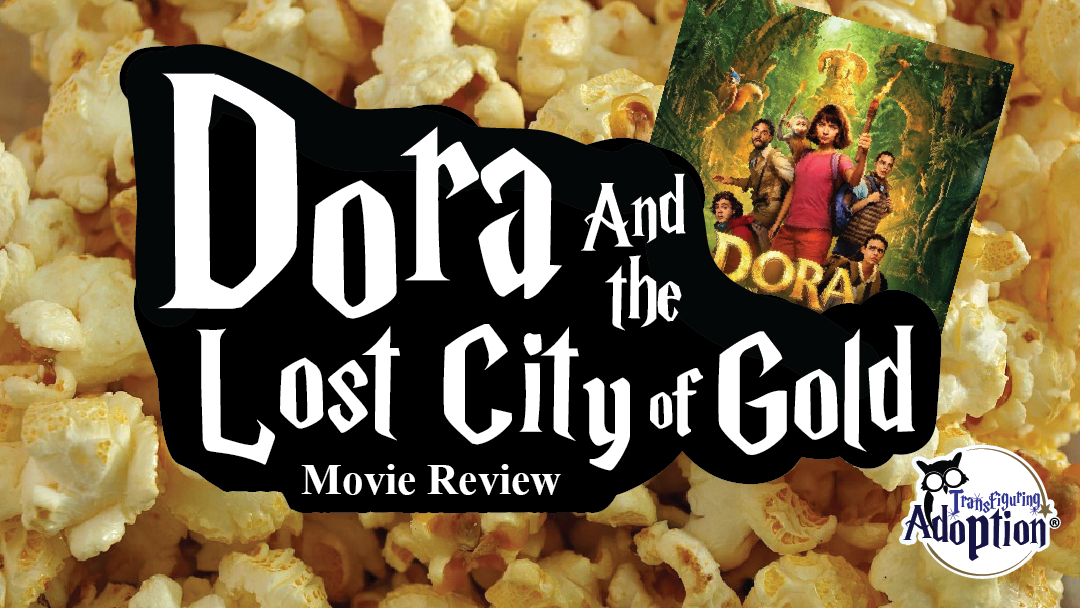Transfiguring Adoption’s Overview:
Dora and the Lost City of Gold (2019) is a long-awaited sequel to the famous U.S. TV series many children have grown up watching. While this film can appeal to many children with slap-stick moments, fart jokes, and the throwbacks to the TV series, caregivers of children from the child welfare system should be cautioned when viewing this film. Many children who have grown up in nurturing families may not have the same struggles with this film as children in care, but what could be considered innocent fun could reflect some serious struggles children in care have due to emotional and social neglect in crucial developmental years. This should be a film that caregivers make a point to watch with their older children in care and be prepared to discuss some important concepts after relating to health parent/child boundaries, stranger danger, and how a safe, capable adult should care for children. Younger children will not understand most of the film and will struggle to follow the fast-paced plot and older teens most likely will find the film to be “baby-ish” due to overreliance on humor points such as fart jokes.
** Spoilers Could Be Ahead **
How Is This Relevant To Adoption & Foster Care?
Dora is presented in the film as being a very capable and bright explorer raised in the Peruvian jungle with her parents, Cole and Elena, who are professional explorers. The title as explorer is presented as being very important as these are the “good guys” compared to bad “treasure hunters”. However, once Dora is placed with her cousin Diego’s family in California the family begins to notice that Dora is a little… different from her peers. From bringing exploration tools to school (setting off the metal detector and making everyone late for class) to how to she breaks the fourth wall to address the audience Dora receives much criticism to the disgust of her cousin, Diego, who has grown up in the area and grows embarrassed by Dora’s behavior. Dora doesn’t care about how others think about her and while this is admirable, Dora’s overconfidence in herself and lack of “stranger danger” leads her and her classmates into the trap of some very dangerous people who openly threaten her harm. Even after being duped in the initial trap, Dora is again tricked when an adult named Alejandro identifies himself as a National University of San Marco Professor and states that he is a “friend” of her parents. His verbal proof of this is that he remembered seeing Dora as a baby and recognized her. Later it is revealed that Alejandro is actually the leader of the very treasure hunters who kidnapped Dora and company to begin with! Throughout the film, in spite of Dora displaying such naivety, Dora is portrayed as being more competent than adults around her, such as Alejandro, her parents, and other adults that may mean well but appear clueless. This lack of stranger danger and lacking the ability to trust adults are both commonly present (sometimes simultaneously) with children in care of the child welfare system due to inappropriate parent/child boundaries in relationships and lack of knowledge in what adults are trustworthy. In addition to this, due to feelings of being left behind, being let down, and neglect many children feel the need to display over competency in order to control their environment and create a felt sense of safety. Though this film may not overtly support the idea that caregivers are capable and safe a caregiver can use this film as a way to see how a child may perceive safe vs. unsafe adults and work with children to build social emotional skills and learn how to identify and trust safe adults.
Discussion Points:
- Stranger Danger
One of the biggest concerns in this film addressed is the danger of a child walking away with an adult who claims to “know parents” or gives some other indication to trick a child into leaving with a stranger. Many children in foster care have not been taught to defend themselves against stranger danger and may attach to easily with adults who may not have their best interests at heart. Caregivers can look at Dora’s naivety and learn from her lack of awareness of danger due to living in a space where stranger danger was not taught and Dora’s definition of danger being very different from that of her peers. Caregivers can also use her abduction and (ultimate) betrayal as an example to children in their care as to why tools such as safe words and identifying safe adults is very important. - Healthy Boundaries
During the film Dora struggles with the parent/child dynamic after years of her parents allowing her to swing around the jungle and remain fairly independent for most of her childhood. She bucks especially in response to having to move to California and attend public school. Though for different reasons, children in the child welfare system often have different definitions of a typical parent/child relationship from that of caregivers. Sometimes this can be a cultural variant and sometimes this can be due to a child acting as an additional parent in a sibling group. Caregivers can work through discussion points concerning this to build insight on where a child may be coming from when acting “defiant”, when in reality a child believes they have truly been disrespected and is responding in a corresponding manner. - Social Skill Building
Due to many years of Dora’s primary social contacts being her parents and Boots (a monkey) Dora is presented as lacking in social emotional skills needed for interacting with her peers. Some children in the child welfare system come from varied backgrounds with different cultural norms, but most children in care struggle with social emotional skills due to developmental delays and neglect during crucial points in development. Caregivers can use Dora’s examples in the film as ways to discussion social emotions, social skills, and social boundaries for interacting with peers, adults, and strangers.
Cautionary Points:
- Adults Portrayed As Incompetent
This portrayal further instills in Dora that her family’s safety rests on her shoulders and cannot trust adults to search for her parents or get back to safety. This can be problematic for children who have not had consistency from caregivers and perhaps have been treated as an “extra parent” in sibling groups. This can specifically create problems in the caregivers home while trying to instill appropriate parent/child boundaries. - Several Unrealistic Stunts
Children may see some stunts done by Dora and friends and attempt to solve their own “ruin puzzles” and such. Caregivers should be mindful of this and prepared to explain to children that Dora and company’s stunts (i.e. – swinging from vines, jumping across ravines, near drowning experiences, dangerous animal interactions, etc.) are fictitious and can end in injury. - Use of Hallucinogenic Plants
During the middle of the film Dora and Alejandro are exposed to a plant that expels hallucinogenic spores, resulting in Alejandro stripping naked and running away into the jungle manically and leaving Dora alone in the jungle. Dora experiences intense hallucinations and is able to speak to cartoon versions of her friends, Backpack, Boots, etc. and takes part in some risky stunts. This could be problematic to children in care due to exposure to substances and caregiver use of substances and could trigger survival behaviors as a response to unresolved trauma. - Bullying
Dora is portrayed as a socially awkward, homeschooled child among her peers and, as a result of her strange behaviors and high intelligence, is bullied by her peers and cousin. This may be hard for children who are bullied. Dora’s Abuelita does a fantastic job of addressing this with Dora, but a warning is still warranted. - Dora Is Somewhat Stigmatized Regarding Mental Health
Especially in the beginning, Dora addresses the audience as she did in the hit TV series. Instead of ignoring this interaction and pause, others in the film react as if Dora is “crazy” or hallucinating. Some of her awkward behaviors are also treated in a similar manner, though never formally addressed via therapy of assessments. Eventually this theme is dropped, but caregivers should take note that children who have had socially awkward experiences due to symptoms of diagnoses (i.e. – responding to internal stimuli) may find this problematic. - Moving
During the film Dora experiences losing her cousin and best friend, Diego, due to him moving from Peru to California. Later, Dora struggles immensely with moving away from her home (the jungle) and having to integrate with the culture of urban and public school life. This can trigger a response for children in care due to the trauma of moving out of the home of origin and into the foster care system as well as the movement between homes in the foster care system. - Kidnapping
Dora and her friends (and later, her parents) are all kidnapped twice, once by a band of thugs and Swiper, and once by an adult who posed as a family friend. Both the perceived loss of Dora’s parents and the actual kidnappings and threats could be seen as highly triggering for children in care that have experienced unsafe adults and human trafficking. - Several Suspenseful Moments
This includes near drownings, quick sand, kidnappings, violent threats of harm, weapons drawn on children, car chases, interactions with dangerous animals, etc. - Dora Has Poor Boundaries With Others
Dora is shown to give over-aggressive hugs, get too far in others’ personal space, trust adults she has never met, and greeting strangers in airports. This can be problematic as children in care sometimes struggle with safe, appropriate boundaries due to developmental delays or poor examples of boundaries. - Dora Brings a Knife and Other Unsafe Items to School
This includes a large knife and a signal flare. This may trigger children who struggle with felt safety or bringing inappropriate items to school. - Fart/Poop Humor
Just throwing this in there as a head’s up as caregivers will probably hear references to the fart jokes for several weeks. If this is a struggle in a caregivers home, you have been sufficiently warned.
[Donate to this Project]
About the Author: Rachael Rathe
Rachael B. Rathe is an East Tennessee native with a Bachelor of Arts Degree in Psychology with a Minor in Child & Family Studies from The University of Tennessee Knoxville. She has worked in mental health since 2013 and in foster care/adoptions for a private provider agency since 2014. Rachael was inspired to work in the field after working with children and teens on a volunteer basis 2008 – 2013. Rachael’s ideal self-care day involves snuggling on a couch with her kitties (Tabitha, Fergus, and Rufus) while enjoying a good movie or book. She also enjoys galavanting around conventions concerning all things nerd and geekery.
**Transfiguring Adoption is a nonprofit organization seeking to nurture growth in foster and adoptive families by giving a HOOT about their families. Transfiguring Adoption does not intend for its reviewers nor its review to be professional, medical or legal advice. These reviews and discussion guides are intended to help parents to better be able to connect and understand their children who come from traumatic backgrounds.

